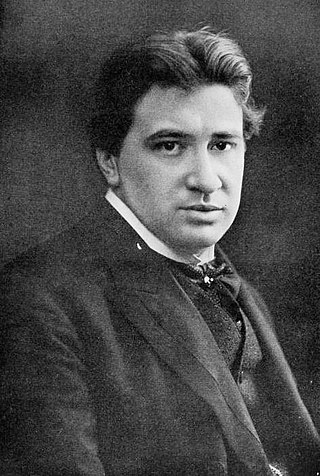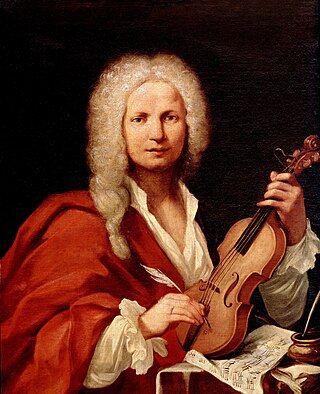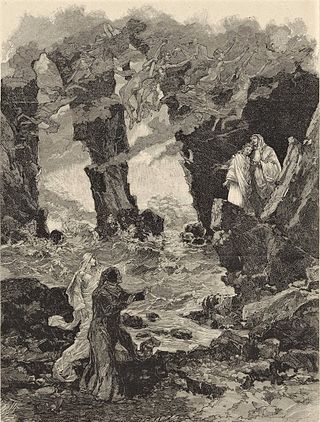
Amilcare Ponchielli was an Italian opera composer, best known for his opera La Gioconda. He was married to the soprano Teresina Brambilla.

I quatro rusteghi is a comic opera in three acts, music by Ermanno Wolf-Ferrari to a libretto by Luigi Sugana and Giuseppe Pizzolato based on Carlo Goldoni's 18th-century play I rusteghi. The opera is written in Venetian dialect, hence "quatro" instead of "quattro".

Salammbô is an opera in five acts composed by Ernest Reyer to a French libretto by Camille du Locle. It is based on the homonymous novel by Gustave Flaubert (1862). Initially refused by Paris, Reyer's opera enjoyed its first performance at the Théâtre Royal de la Monnaie in Brussels, on 10 February 1890, with sets designed by Pierre Devis and Armand Lynen. The Parisian premiere at the Palais Garnier took place on 16 May 1892 with costumes by Eugène Lacoste and sets by Eugène Carpezat, Auguste Alfred Rubé and Philippe Chaperon, and Amable and Eugène Gardy.

Guntram is an opera in three acts by Richard Strauss with a German libretto written by the composer. The second act of the opera was composed in Ramacca, Sicily.

Ivanhoé is an 1826 pastiche opera in three acts with music by Gioachino Rossini to a French-language libretto by Émile Deschamps and Gabriel-Gustave de Wailly, after Walter Scott's 1819 novel of the same name. The music was adapted, with the composer's permission, by the music-publisher Antonio Pacini from Rossini's operas, namely Semiramide, La Cenerentola, La gazza ladra, and Tancredi in order to introduce his music to Paris. An examination of the score shows that Pacini also used music from Bianca e Faliero, Armida, Maometto II, Aureliano in Palmira, Sigismondo, Torvaldo e Dorliska, Mosè in Egitto and an amount of newly composed music including fanfares and the gallop that was later to become famous from its inclusion in Guglielmo Tell. The work was premiered on 15 September 1826, at the Odéon Theatre.
Nerone (Nero) is an opera in four acts composed by Arrigo Boito, to a libretto in Italian written by the composer. The work is a series of scenes from Imperial Rome at the time of Emperor Nero depicting tensions between the Imperial religion and Christianity, and ends with the Great Fire of Rome. Boito died in 1918 before finishing the work.

Gli equivoci, is an Italian opera buffa by Stephen Storace to a libretto by Lorenzo Da Ponte, based on Shakespeare's The Comedy of Errors.

Scanderbeg is an opera in three acts composed by Antonio Vivaldi to an Italian libretto by Antonio Salvi. It was first performed at the Teatro della Pergola in Florence on 22 June 1718 to mark the re-opening of the theatre to public performances. While the libretto has been preserved, only fragments of the original score remain.
Giulietta e Romeo is a dramma per musica by composer Niccolò Antonio Zingarelli with an Italian libretto by Giuseppe Maria Foppa after the 1530 novella of the same name by Luigi da Porto. The opera premiered at the Teatro alla Scala in Milan on 30 January 1796.

Antigone is an opera in three acts by Arthur Honegger to a French libretto by Jean Cocteau based on the tragedy Antigone by Sophocles. Honegger composed the opera between 1924 and 1927. It premiered on 28 December 1927 at the Théâtre Royal de la Monnaie with sets designed by Pablo Picasso and costumes by Coco Chanel.

Medea is an opera in three acts composed by Giovanni Pacini to a libretto by Benedetto Castiglia. It premiered on 28 November 1843 at the Teatro Carolino in Palermo, conducted by the composer with Geltrude Bortolotti in the title role. The libretto is based on the plays Medea by Euripides and Médée by Pierre Corneille.

Issé is an operatic pastorale héroïque by the French composer André Cardinal Destouches. Initially it was in three acts. The definitive revised version consists of a prologue and five acts. The libretto was by Antoine Houdar de la Motte. Although Destouches was only 25 at the time of its premiere, it is considered his best score.

Antonio Cagnoni was an Italian composer. Primarily known for his twenty operas, his work is characterized by his use of leitmotifs and moderately dissonant harmonies. In addition to writing music for the stage, he composed a modest amount of sacred music, most notably a Requiem in 1888. He also contributed the third movement, Quid sum miser, to the Messa per Rossini, a collaborative work created by thirteen composers to honor Gioacchino Rossini.

La rosa bianca e la rosa rossa is an opera in two acts composed by Simon Mayr to an Italian libretto by Felice Romani. It premiered at the Teatro Sant'Agostino, Genoa, on 21 February 1813. Set in England against the backdrop of the Wars of the Roses, Romani's libretto is based on René-Charles Guilbert de Pixérécourt's La rose blanche et la rose rouge. Mayr's opera has also been performed under the title Il trionfo dell'amicizia.

Arturo Cadore was an Italian composer and organist. Born in Soresina, he primarily composed operettas and parlor songs, and comic operas. He is also known for having completed Amilcare Ponchielli's opera I Mori di Valenza which had been left unfinished when the composer died in 1886 and was premiered posthumously in 1914. In his later years he was the organist at the Chiesa di San Vittore in Olona. Cadore died in Gaggiano at the age of 51.

Jacqueline Royer was a French opera singer who sang leading contralto and mezzo-soprano roles at the Opéra de Paris, London's Royal Opera House, the Teatro Colón in Buenos Aires, and the Opéra de Monte-Carlo. Active on the stage from 1904 until 1924, she created several roles in early 20th century operas, including Carmine in the posthumous premiere of Ponchielli's I Mori di Valenza.

Teresa "Teresina" Brambilla was an Italian soprano who sang in the major opera houses of Europe in a career spanning 25 years. She was particularly noted for her interpretations of the leading roles in operas by Amilcare Ponchielli, whom she married in 1874.
Nitocri is an opera in two acts composed by Saverio Mercadante to libretto by Apostolo Zeno adapted by Lodovico Piossasco Feys. The libretto is a fictionalised account of the Egyptian queen Nitocris. The opera premiered at the Teatro Regio in Turin on 26 December 1824.

Françoise de Rimini is an opera in four acts with a prologue and an epilogue. The last opera composed by Ambroise Thomas, it sets a French libretto by Michel Carré and Jules Barbier which is based on an episode from Dante's Divine Comedy. The opera was first performed by the Paris Opera on 14 April 1882 but fell into relative obscurity until its revival in 2011.















